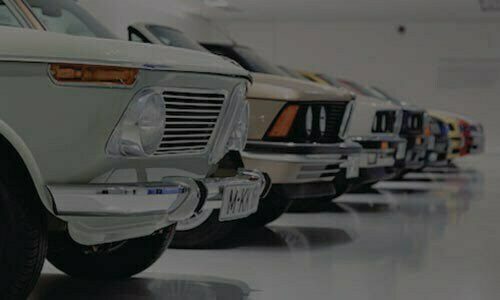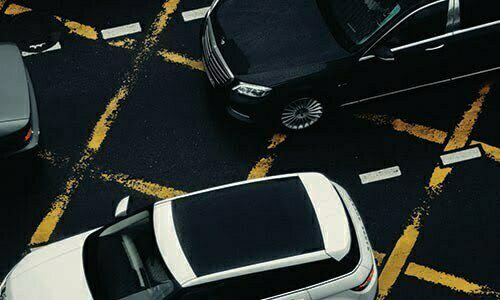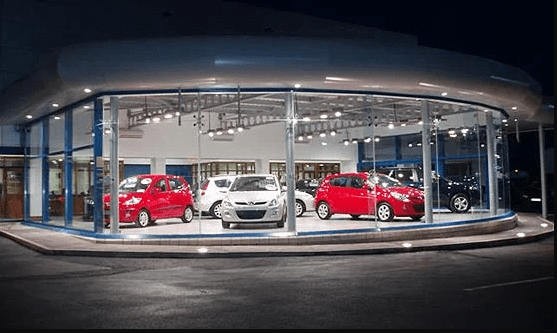Classic Cars
The 1957 Gaylord Gladiator is one of the rarest and most unique of the 1950’s cars.
Developed by the super-rich Gaylord Brothers of Chicago to compete with the world’s best vehicles, including Rolls-Royce.
The Zeppelin Group once manufactured a car that looked like it was made for a Hollywood movie. It appears similar to Batman’s Batmobile or a tuxedo out of the 1920s. It has 305 horsepower and measures more than 4 meters in length. The Zeppelin Group made history with that one of a kind automobile.
How it began: Two wealthy brothers and a dream
Jim and Ed Gaylord were two American brothers that had a soft spot for cars and everything that was fast and expensive. Their father made the family rich by inventing the famous “Bobby Pin”, a hair needle that would rescue many woman around the world from bad hair days ever since. In the early 1950s the brothers were looking for a new toy: a truly exceptional sports car built for them. That would – if built successful – become the dream car of many Americans. The design of the car hailed from the famous Brooks Stevens, an American design legend and true expert on his field. The realization of the car was meant to come from Germany – because the brothers already knew the quality label of “made in Germany” back then.
Quality made in Germany
After failing with the first bodywork the brothers decided to give the task to the so-called “FIF”, a vehicle repair facility at Friedrichshafen. Building the car took more than a year, lots of sleepless nights, many transatlantic calls and frequent travels of the brothers between America and Friedrichshafen. But they never gave up, believed in their dream end kept on working on the spectacular car. And in the end the FIF delivered. In 1957 the car was finally ready. And in 1960, the FIF would go on to become part of the Zeppelin Group.
Ahead of its time: technical sophistication meets German workmanship
Looking at the features of the car, one could tell that the Gaylord brothers did not only have a fine taste. They also had a sense of what modern cars of today would be equipped with. The car had convenient features such as electrically adjustable seats, electric windows, power steering, brake servos and air conditioning. The Gaylord Gladiator also came with a convertible roof that could be folded down completely into the trunk at the touch of a button. It had spare wheel that could be conveniently slided out by just tipping a finger and an interior space equipped with fine dark wood. The signature element, a sword, was not only integrated into armatures like the clock or the speedometer. Also the key of the Gaylord Gladiator was a sword, again proving the exquisite and luxurious approach of the car.
The price was high – and the Gaylord way too expensive
Despite the sophisticated overall concept the plan to produce a small batch of 25 vehicles for sale at a price of USD 10,000 each never saw the light of day. The car was simply too expensive in production. Only one of the 25 cars was ever built, marking the Gaylord Gladiator a true one of its kind on this earth.
After finishing the car, it soon became apparent that the calculated sales price was unrealistic. To remain economically viable, the price was first raised to USD 15,000 before being revised upward again to USD 17,500. Assuming an exchange rate of DM 4.20 to the dollar in 1957, the Gaylord Gladiator cost more than DM 73,500 in 1957. By way of comparison, a Mercedes 300 SL cost around 32,000 Deutschmarks back then! The unique Gaylord Gladiator therefore was never replicated, it stayed the only automobile of its type in the world. And an unique specimen in the classic car industry. Looking at the exquisite and extraordinary craft, the car is also a true gem of Friedrichshafen’s industrial heritage.
How the story of the Gaylord continued
In total, only three chassis of the Gaylord Gladiator were produced in all, with the bodywork only being completed on one of them. So besides the finished Gaylord Gladiator, there existed two more chassis. One of them got completely lost and was never found again, the other one was in the possession of the Gaylord family (together with lots of spare parts). As time went by, the Gaylord Gladiator and the single remaining chassis were part of the Gaylord family and therefore preserved very well. In the mid-90’s, the Gaylords decided to put the Gaylord Gladiator in restoration so that the car would be preserved for many more years to come. After the death of Jim Gaylord, his wife and widow became owner of the Gaylord Gladiator and the single remaining chassis in 1999. She then sold both items (including the spare parts, design drawings and other historical documents) to an elderly automobile collector from Arizona in 2015. The collector had a heart for the car and began researching its origins. He then stumbled upon the engraving “Zeppelin” in the engine compartment of the car and contacted the Zeppelin Museum in early 2017.
How the Gaylord found its way back to Zeppelin
From then on, pure chance led to the Zeppelin Group reclaiming this unique specimen. In early 2017, the Zeppelin Group received an invitation via the Zeppelin Museum in Friedrichshafen to buy the classic car – a stroke of luck for the Group, as the vehicle had lain under the radar for many years and was believed to be lost. The Zeppelin Group decided to buy the car, the remaining chassis and all belonging documents, to honor and preserve the Groups history. It is now permanently on display in the Zeppelin Museum in Friedrichshafen as a loan from the Zeppelin Group. Together with the chassis, the Gaylord Gladiator is a major attraction for the city of Friedrichshafen and at the same time historical evidence of the city’s great innovative strength.
Pictured:The Gaylord brothers with their Gaylord Gladiator.
Archive of the Luftschiffbau Zeppelin GmbH
MORE VEHICLES
GAUK has developed powerful aggregation software that is monitored by real, live humans and only sources clean data.
AUCTIONS
Search ALL vehicles coming up for auction at the country’s leading sale rooms.
CLASSIFIEDS
Each day we gather up-to-the-minute information from multiple car classifieds websites across the internet
DEALERS
Search, save and compare car dealer vehicles across the entire UK.
Always reliable
“The GAUK Motors app has been a gift. I used to waste hours a day searching different sites and monitoring emails. Now I just set up a search and I’m done”
Easy to use
“I used the free service for a while and it wasn’t until I upgraded that I realised just what a fantastic app you’ve built. I’m a customer for life.”
Great Company
“Hey GAUK. Awesome app. I use it on a daily basis and just bought my first classic car … an EType Jag of all things”
Well done!
“I never usually write reviews but after watching GAUK grow I just wanted to say well done and keep up the great work”
Not what I expected!
“There a lot os sites out there promising great things. It was so refreshing to find that you guys actually delivered on all that marketing hype. Cool!”
Looking forward to it
“The GAUK Motors Newsletter is the only one I look forward to seeing drop into my inbox”
What they’re saying
The Best Experience
GAUK has consistently delivered quality information. Thousands of vehicles from hundreds of websites making your perfect ride … easier to find.
GAUK MOTORS
Used Car Search Engine Trusted by 2.5 Million Customers Since 1999
Posts
- Munro Vehicles continues development and scale-up as all-electric 4×4 Munro®MK_1 makes public debut at Low Carbon Agriculture 2023 show, NAEC Stoneleigh, UK
- Designed and engineered to enable agriculture and other demanding terrain-based sectors to cut emissions without compromising on off-road performance
- Unique combination of state-of-the-art electric powertrain and best-in-class mechanical 4×4 driveline
- Priced from £49,995, deliveries commence in 2023
Munro Vehicles, a manufacturer of all-electric 4x4s, and Scotland’s only volume production car company, will gave its first vehicle, the Munro MK_1, its public debut at the Low Carbon Agriculture 2023 show at NAEC Stoneleigh Tuesday 7th to Wednesday 8th February.
The Munro MK_1 combines a state-of-the-art 280kW electric powertrain with a proven, robust, simple-to-maintain mechanical driveline. Ultra-utilitarian and explicitly user-focussed in nature, the Munro is engineered to provide a unique solution for those wishing to minimize their environmental footprint without compromising off-road ability, performance and practicality.
“Meeting the demanding needs of the agriculture sector was foremost in our minds when we were developing the Munro MK_1,” explains Munro CEO Russell Peterson, who co-founded the company with Head of Powertrain Ross Anderson in 2019. “Spending much of my formative years on a farm and then running my own agricultural contracting company, I know only too well how important it is to have proper, proven kit that you can rely on whatever the weather and the conditions, and that won’t let you down no matter how much abuse you throw at it. And every Munro is engineered around those enduring values.”
Priced from £49,995 with deliveries due to commence later this year, the appeal of the Munro MK_1 extends far beyond field and farmyard. Offering an optimum range of up 190 miles and the flexibility to operate off-road for up to 16 hours on a single battery charge, the Munro’s unique attributes are equally suitable for those working in challenging sectors such as construction, mining, environmental, emergency rescue, remote infrastructure maintenance, in addition to recreation.
Munro takes an equally innovative and disruptive approach to the marketing and maintenance of its products. The company will select a global series of agents and will recognise the customers’ right to repair and maintain their vehicle without invalidating its full five-year / 100,000-mile warranty.
The company has already established a partnership with Marc Monsarrat, director of Oxfordshire-based Off-Road Electric, which specialises in supplying fully electric utility vehicles to working farmers, landowners, and institutions in the UK. Monsarrat, who will join the team at Low Carbon Agriculture 2023, commented: “Until now, there has not been a solution for farmers wishing to decarbonise their work fleet with a new electric 4×4 vehicle. Munro changes all that. With the ability to transport a crew of five over all terrains, operate for up to 16 hours on a single battery charge and provide a 3500kg towing capacity, this is a highly durable vehicle engineered to offer real workhorse capability, day after day, decade after decade, without any tailpipe emissions.”
Motoring
- Lunaz Design reveals upcycled 1961 Bentley S2 Continental
- Rarest classic car ever to be converted to fully electric power
- One of four examples ever made, originally powered by a 6.2-litre V8
- Completed at Silverstone, UK production and research facility
- Latest application of proven Lunaz upcycling process and technologies
- Extensive use of sustainable and recycled materials
- Transformation is the latest chapter in car’s eventful life
- Confirms Lunaz Design as de facto upcycling brand for luxury cars
“This magnificent Bentley S2 Continental was already an exceptional motor car, as one of just a few examples of its type that remain in the world. In its new guise, it’s the rarest vehicle ever to be converted to fully electric propulsion, and the most exclusive project we’ve ever undertaken at Lunaz Design: it’s literally one of a kind. This car is also a further demonstration of our proven upcycling process and technologies, developed entirely in-house at our Silverstone facility, which are fast becoming the de facto gold standard for electrification projects involving the world’s most prestigious marques.”
David Lorenz, Founder, Lunaz
Lunaz Design has unveiled the rarest classic car ever to be transformed to fully electric power.
Dating from 1961, this specific Bentley S2 Continental is one of only four examples built. In its original specification, it was powered by a 6.2-litre V8 petrol engine. Today, now completely restored and reimagined, it’s equipped with Lunaz’s in-house designed proprietary modular electric powertrain, which comprises high-grade Tier 1 OEM battery cells and motors.
The latest in a series of luxury classic cars to undergo the company’s proven upcycling process at its facility in Silverstone, UK, previous projects include models from famous names including Aston Martin, Jaguar, Range Rover and Rolls-Royce.
Bentley S2 Continental
This specific example was built in 1961. In period, a small number of luxury car bodies were still being produced by independent coachbuilders to the customer’s specification, on a ‘rolling chassis’ supplied by Bentley or an other manufacturer. According to the build sheets, the first owner initially commissioned a four-door body from leading London coachbuilder James Young; but he evidently had a change of heart at the last minute, since research shows the car has only ever existed in its present two-door form.
In 1967, the car changed hands for the first time. Over the decades that followed, it would reside with various owners as far afield as Germany and Japan before returning to the UK. The Bentley Continental was always the rarest S2 variant – the Standard and Long Wheelbase versions represented more than 80% of the total number produced – and today, this specific car is one of only a handful left in the world.
All Bentley S2 variants were powered by the then-new ‘L’ Series 6.2-litre V8 engine, made from aluminium alloy for an improved power-to-weight ratio. This ensured the engine could sustain the power demands of automatic transmission, power steering and air conditioning with no loss of performance.
The Lunaz upcycling process
Undergoing the same upcycling process proven on a number of rare, high-value luxury cars over the past four years. The result is a Concours-standard vehicle that meets Lunaz’s three key requirements for an upcycled electric vehicle: usability, reliability and sustainability.
It starts with a detailed inspection and assessment to determine the chassis, powertrain, and suspension configurations. Lunaz Design’s engineers use 3D scanning to create detailed Computer Aided Design (CAD) models as the basis for any renovation and reconstruction work required.
The car body is then stripped down to a bare metal shell and returned to as-new condition using traditional coachbuilding and restoration techniques. Any external and internal materials are repaired and recoated: anything that can’t be reused, down to the nylon in the seatbelt cord, is recycled.
The internal combustion engine and its associated systems, lubricants and other fluids are carefully removed and reclaimed, then replaced with Lunaz’s proprietary fully-electric powertrain. The modular design, developed entirely in-house, allows engineers to adjust individual components to perfectly reflect the car’s innate character, and the owner’s personal preferences. The battery cells, inverters and motors are all original equipment made to Lunaz’s specification by European Tier 1 suppliers, as used by OEM carmakers.
Other vital systems, including brakes, steering, suspension and electrics, are all given Lunaz Design’s full modernisation treatment to bring them into line with the dynamic expectations of the customer as well as current safety standards.
As specified by the client, the fully electric Bentley S2 Continental is now equipped with a clean-air 400 bhp powertrain, producing 530 lb-ft of torque. 0-62 mph is achieved in 6.9 seconds. To ensure handling capability in line with contemporary standards, suspension is uprated to a fully adjustable coil-spring suspension with a lever arm damper. This is configurable electronically from the cabin of the car. Likewise, its brakes, which also incorporate a battery regeneration system, have been upgraded to six-piston calipers in the front and four-piston variants in the rear.
Sustainable luxury interior
In its new incarnation, the Bentley retains its luxurious character; but in keeping with its zero-emission powertrain and Lunaz Design’s culture of upcycling, the interior now incorporates a much higher proportion of sustainable materials than the original.
All seat leather is made from hides tanned using naturally-fallen olive leaves, the carpet in the front and rear cabins and boot is made from 100% regenerated nylon fibre and incorporates a backing made from 100% recycled plastic bottles. Similarly, all the wood veneers used on the dashboard and other areas are from sustainable sources, certified by the Forestry Stewardship Council (FSC).
Motoring
The company made significant progress during the year on its strategic ambitions, as it accelerated towards the aim to become a fully electric car company by the end of the decade and climate neutral by 2040.
- FY22 revenue up 17 per cent to 330.1 bn SEK (282 bn SEK in FY21)
- FY22 operating income (EBIT) was 22.3 bn SEK (20.3 bn SEK in FY21)
- FY22 EBIT margin was 6.8 per cent (7.2 per cent in FY21)
- FY22 EBIT margin excl. share of income from JVs and associates was 5.4 per cent (7.5 per cent in FY21)
- FY22 Basic earnings per share was 5.23 SEK (4.72 SEK in FY21)
- FY22 Fully electric car sales accounted for 11 per cent of total sales (4 per cent in FY21)
- Q4 revenue was 105.2 bn SEK (80.1 bn SEK in Q4 2021)
- Q4 operating income was 3.4 bn SEK (3.7 bn SEK in Q4 2021)
- Q4 EBIT margin was 3.3 per cent (4.6 per cent in Q4 2021)
- Q4 EBIT margin excl. income from JVs and associates was 3.7 per cent (7.1 per cent in Q4 2021)
- Q4 Basic earnings per share was 0.82 SEK (0.66 SEK in Q4 2021)
- Q4 fully electric car sales share at 18 per cent (6 per cent in Q4 2021)
Volvo Cars today reports an operating profit, including joint ventures and associates, of 22.3 billion SEK and a profit margin of 6.8 per cent for the full year 2022, as it faced prolonged supply constraints, lockdowns in China and elevated material and logistics costs during the year. The interim report for the full year and fourth quarter can be found here.
“We managed through the heavy turbulence of the year and made significant progress on our strategic ambitions in 2022, as we accelerated towards our aim to become a fully electric car company by the end of the decade and climate neutral by 2040,” said Jim Rowan, President and Chief Executive of Volvo Cars.
Already by the mid-decade, Volvo Cars aims to reach a 50 per cent global sales share of fully electric Volvo cars, with a 40 per cent lower carbon footprint per car and profitability of 8-10 per cent. “We remain steadfast on that strategic journey,” added Jim Rowan.
Sales performance
In 2022, the performance of the company’s fully electric cars stood out as a real highlight. Sales of Volvo’s electric cars more than doubled compared with the previous year, resulting in 11 per cent of full-year sales attributed to fully electric cars compared with 4 per cent in 2021.
This includes a strong performance in sales of pure electric cars in the fourth quarter, reaching the highest point ever at 18 per cent compared with 6 per cent in the same period last year. This was despite overall sales being affected by production constraints. As a result of this performance, the company’s market share in the fully electric segment increased significantly during the year compared with the same period last year*.
The performance of the company’s Recharge cars, which includes both fully electric cars and plug-in hybrids, was strong with a share of 33 per cent for the year and 41 per cent during the fourth quarter. Of note was the performance in Brazil, Uruguay, Thailand and Indonesia during the last three months of the year. These markets reached a Recharge sales share of 100 per cent in Q4, closely followed by Norway at 98 per cent, Ireland at 91 per cent and Sweden with 89 per cent.
In 2022, Volvo Cars’ revenues reached 330.1 bn SEK, up 17 per cent compared with the previous year. This is the highest ever revenue recorded in the history of the company, attributable to a better product mix, higher price realisation on the cars, foreign exchange tailwinds and contract manufacturing with Polestar.
Operating performance
In 2022, EBIT excluding JVs and associates reached 17.9 bn SEK, down 15.7 per cent compared to 2021. The EBIT margin for the full year stood at 5.4 per cent. Despite a favourable product mix and strong pricing, the EBIT performance was affected by lower volumes on the back of production constraints, increased raw material and freight costs, and spot-buying of semi-conductors. For the duration of 2023, the company anticipates that raw material prices, especially lithium, will remain at elevated levels and spot-buying of semi-conductors will continue.
EBIT including JVs and associates came in at 22.3 bn SEK for the year, up 10 per cent compared with 2021. This translated into an EBIT margin of 6.8 per cent for the year. The higher EBIT for 2022 was mainly due to the accounting effect of Volvo Cars’ shareholding in Polestar following their listing on the Nasdaq Stock Exchange in New York last year.
Supply chain and CO2 reduction
Manufacturing output improved in the second half of the year, particularly during the fourth quarter. For the last six months of the year, production increased by 15 per cent compared with the first half of the year on the back of an improved supply situation.
The number of active subscriptions at the end of 2022 increased by 49 per cent compared with the previous year. For the full year of 2022, the number of Volvo Cars sold online increased 17 per cent compared with 2021. This growth was driven by increasing customer demand in combination with a broadened offer in more markets.
The strong sales momentum of the Recharge line-up of fully electric and plug-in hybrid cars during the year contributed to a CO2 reduction per car of 15 per cent compared with our 2018 benchmark, supporting the company’s mid-decade ambition of reducing CO2 per car by 40 per cent.
2023
While 2023 looks to be another challenging year, the company is hopeful that the COVID-related supply shortages from China are behind it and that it continues to see steady improvement in the supply of semi-conductors. In addition, Volvo Cars is optimistic that the price of lithium will start to decline towards the end of the year, in line with many of the independent reports recently published. Despite the global turbulence, uncertainty and the recent price increases, Volvo Cars continues to see healthy demand for its cars. As ever, the company continues to closely monitor the external environment and adapt accordingly.
To help offset increased costs, the company has recently reinforced a comprehensive cost and efficiency optimisation plan across the organisation. This is aimed at delivering on Volvo Cars’ strategic ambitions with better utilisation and optimisation of resources. It is clear now that uncertainty and volatility are the inescapable business realities of today, and therefore creating a more cost-aware culture is a key building block for the future.
So, if 2022 marked the acceleration of the company’s strategic journey in the face of unprecedented global disruption, 2023 will be a pivotal year as the company further accelerates on that transformation path.
Volvo Cars will launch a new small fully electric SUV during the year, which will take the company to a new demographic, and start production of the Volvo EX90. This year, the company will also transform the UK operation from a traditional wholesale business to become direct consumer facing with a seamless consumer experience and national pricing. NOVO Energy, the joint venture company with Northvolt, will take a crucial step towards developing sustainable battery technology with the start of construction of one of Europe’s largest battery cell plants in Gothenburg.
Volvo Cars expects a solid double-digit growth in retail sales during this year, provided there are no unexpected supply chain disruptions. The company intends to continue increasing its volumes for fully electric cars in 2023, taking the full year share higher than 2022’s share of 11 per cent.
“We have demonstrated in 2022 that we have turned up our execution engine. This will continue to deliver in 2023,” said Jim Rowan.
Motoring
- Isuzu UK registrations for January 2023 are up 102% compared to January 2022
- Increase is largely thanks to double cab automatic and single cab manual 4×4 registrations
- Managing Director, Alan Able, thanks “tireless efforts” of Isuzu Dealer Network for good performance
Isuzu UK has continued to increase pick-up registrations, with January 2023 registrations over 100% up from January 2022 despite the ongoing market issues leading to strains on vehicle supply.
With the LCV market slowly picking back up amidst global supply troubles, Isuzu UK remains in an exceptionally positive position, with overall registrations for January increasing by 102% compared to January 2022. This two-fold increase in registrations is largely thanks to Isuzu UK’s double cab automatic pick-ups, which alone witnessed an astounding 319% increase in registration for January 2023 compared to January 2022. Additionally, a registration increase of 385% for single cab 4×4 manuals this January compared to last also massively contributed to Isuzu UK’s overall registrations for the month.
Alan Able, Managing Director of Isuzu UK, said: “We are thrilled to see a significant increase in vehicle registrations in January, which is a testament to the hard work and commitment of our dedicated dealer network. Their tireless efforts to provide exceptional service to our customers have not gone unnoticed, and we are grateful for their continued support. It is so encouraging to see demand for Isuzu’s vehicles continue to grow, and I am sure this will be a record-breaking year for the brand.”
Earning multiple awards for 2023, the Isuzu D-Max’s exceptional capability combined with refined levels of comfort are key contributing factors to the persistent increase in registrations. Kicking off the year with three awards, the D-Max was awarded the title of Pick-Up of the Year by Company Car & Van, 4×4, and What Van? Magazines. Increased demand for the Award-Winning Isuzu D-Max range can be attributed to the vehicle’s outstanding overall performance, which is reflected with each award.
The Award-Winning Isuzu D-Max range offers a variety of body styles (single, extended, double-cab) to cater to all needs. The Utility specification is aimed at businesses with features like vinyl flooring, cloth upholstery and automatic lights & wipers. The All-Purpose and Adventure models offer more SUV-like features, like keyless entry, climate control, leather interior, reversing camera, and multimedia systems with Apple CarPlay and Android Auto. A five-year / 125,000-mile warranty and five-year roadside assistance are also provided, with the vehicle range boasting a 3.5-tonne maximum towing capacity and 1-tonne payload.









